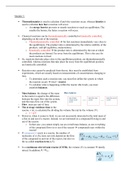Module 3:
Thermodynamics is used to calculate if and why reactions occur, whereas kinetics is
used to calculate how fast a reaction will occur.
o An energy barrier prevents or retards reactions to reach an equilibrium. The
smaller the barrier, the faster a reaction will occur.
Chemical reactions can be thermodynamically controlled or kinetically controlled,
depending on the rate of the reaction.
o Thermodynamically controlled for fast reactions (immediately very close to
the equilibrium). The product ratio is determined by the relative stability of the
products. (salt/pH equilibria, mutarotation).
o Kinetically controlled the product ratio is determined by the rate at which
the products are formed. Far away from the equilibrium. This is the case for
most reactions in food.
So, reactions that take place close to the equilibrium position, are thermodynamically
controlled, whereas reactions that take place far away from the equilibrium position,
are kinetically controlled.
Reaction rates cannot be predicted from theory; they must be established from
experiments, which are usually based on measurements of concentrations changing in
time.
o To determine such a reaction rate, you must first define the system in which
the reaction occurs food = reactor.
o To calculate what is happening within the reactor (the food), you must
establish balances.
- Mass balance: the change of the mass
in the reactor is equal to the difference
between the mass flow into the system,
and the mass flow out of the system.
- Flow: mass per unit of time.
The average residence time in the
reactor, (s), is calculated by dividing the volume flux () by the volume (V).
o = /V
However, when it comes to food, we are not necessarily interested in the total mass of
a flux in and out of a reactor. Instead, we are interested in a compound flowing in and
out of the reactor.
o In that case, you cannot simply use an overall mass balance, as not everything
of the compound flows in or out of the reactor compounds react within the
reactor!
If compound A reacts in a reactor, the number of
molecules of A (Na) does not only depend on the flow
of the compound in and out of the reactor, but also on
the so-called reaction term (raV).
In a continuous stirred tank reactor (CSTR), the volume (V) is constant ideally
mixed. In addition, ϕ ¿ =ϕ out .
, In a closed batch reactor, a certain volume/mass of a material is inserted in a reactor,
where it is left to react. In this case, ϕ ¿ =ϕ out =0.
o As the fluxes are zero, the change in concentration of compound A depends
now directly on the reaction (term).
Generally, foods can be considered closed
batch reactors, as there is no exchange
between the environment and the food.
Although this is not always the case (i.e.,
oxidation reactions), it is assumed for must cases.
In the official IUPAC definition of rate, the rate is related to the extent of the reaction:
dξ
r =ξ= . The rate is thus how fast the extent of a reaction over time is happening.
dt
∆ ni
o Extent reaction = ξ= .
vi
You can calculate the reaction rate for a reaction as a
whole (see formula on the right).
However, often you are not interested in the rate of a whole reaction, but rather in the
rate of one compound. This is a rate that is related to a specific change in the quality
of food. This rate is determined by taking the change in concentration of a compound
−d c i
over time: r i= .
dt
The kinetic equations of reactions can be described by mechanistic and empirical
models.
Empirical approach: you describe your data with a certain order of reaction (zero-,
first-, second- or nth-order). Such reactions are used to describe the rate of changes of
a certain compound.
Mechanistic approach: you make use of elementary reactions.
o Monomolecular 1 reactant (A reacts to B).
o Bimolecular 2 reactants.
o Termolecular 3 reactants.
- Molecularity: the number of reactants in an elementary reaction.
If we describe a reaction in a mechanistic way, the law of mass action applies the
rate of an elementary reaction is proportional to the product of concentrations of the
molecular species involved.
o If A + B = C, the reaction rate is proportional to -k*[A][B].
o If A + A = B, the reaction rate is proportional to -k*[A][A].
There are also more empirical ways to derive reaction rate constants:
o The general rate law is: r =k∗c a∗c b . This is a mechanistic model for, for
example, a chemical reaction.
o a and b are individual orders; the overall order (n) = a + b.




